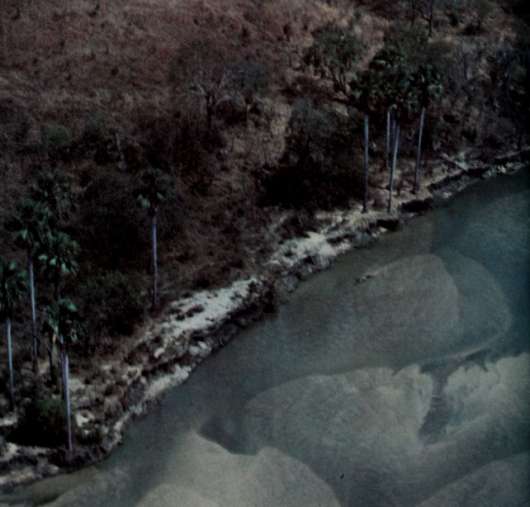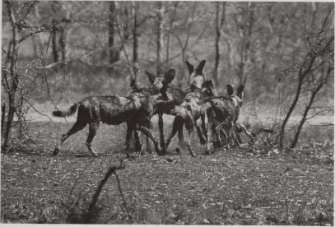Sand rivers (12 page)

(Upper) Mbarangandu River. (Lower) Richard Bonham and crew. (Left) Female impala.

■*^


■-^i^

'Ik

\ >
i

'^ -' -
^
■^^^r?
SAND RIVERS
banks, and the fire leapt away toward Nandanga Mountain. Hugo and I stared at Brian, mildly astonished; in some part of his mind he was still Warden of the Selous.
At sunset, in single file, seven wild striped horses galloped away over the fire-blackened ground against copper leaves, and a bush duiker bounded straight into the ball of sun that touched the horizon of the ridge. Then it was heavy dusk, and quickly dark.
Once on the main track we still had thirty miles to go. The headlights wavered along on the rough road, and a thick-knee struck the windshield and went fluttering off ghost-like into the blackness. A skunk-sized creature with white bushy tail, fleeing the light, ran ahead of us for a hundred yards before darting off the path - this was the mustelid called the zorilla, a lesser relative of the civetr Not far from camp, a spotted eagle owl sat on the track, eating a snake without troubling to kill it; undaunted by the huge night eyes of the car lights, it bit at the small, writhing creature in its talons, then lifted its blood-glistened beak, its yellow eyes, to return our stare. At last the owl rose softly from the track, carrying the shining snake into the trees.

Wild dogs killing a wart hog.
(Left) Wild dog pup.
VI
In the early morning of the next day's journey, while the tents were dismantled and packed into the machines, Mzee Nzui, the head cook, tidied the kitchen. He buried tins, papers, and other takataka, even the plucked feathers of a guinea fowl, under the ashes, then dismantled his dish rack of saplings and fronds; as Maria remarked, Mzee Nzui was much more conscientious about litter than the whites, who were sentimental about the landscapes of the Old Africa while littering it with their cigarette packages.
Since no one was ready I set off on foot, leaving instructions for them to pick me up along the road. Already the sun was shrouded over with dank cloud, and miasmal humidity had settled into the dark woods. Tsetse abounded, though they did not bite. My footsteps in the soft sand of the track made no sound, and in the windless heat and utter stillness the ominous chinking of a tinker bird, the signal of the black-headed oriole, the see-saw creaking of the coqui francolin deepened the silence. None of these birds showed themselves, and the leaves hung limp as bats in the gray, damp air. Letting my eyes fall to the ground, 1 saw big round lion spoor, very fresh, implanted on top of tire marks made the evening before. Retracing my steps a little I found the place where the lion had left the track, and realized that it might be watching me at this very moment, that I might have passed it. If so, 1 was cut off from the camp. Gazing about, I listened attentively, though for what I did not know: it seemed to me that the woods looked rather gloomy. For want of a better plan, 1
82
SAND RIVERS
continued on my way, and eventually 1 heard a Land Rover's quiet hum. Brian picked me up, and we went on past the steam engine, to where the Liwale-Madaba track met the faint track to the south.
Crossing the high grass savanna woodland, we saw scarcely any game at all; not until the track came down into the shallow valley of the Matandu River, a small stream that winds through sour grasslands of black cotton clay, did animals start to appear - a young bull elephant, a yellow reedbuck loping along the wood's edge, then two more by the river, then zebra and hippos and the common antelopes. But the numbers were small, and the sable and greater kudu remained hidden, and Brian became increasingly disgusted. Here, he felt, the scarcity of animals could not be blamed on poachers. The Matandu marks the eastern border of the Selous Game Reserve, but the country beyond the boundaries had been emptied of people years ago in the resettlement schemes set in motion by lonides. No, it was all this unburned grass that had driven the animals away. These tall tussock grasses produced new tissue only during the rainy season; once they had matured and flowered, they turned dry and stalky and lost all nutritive value. If the Selous wef'e to support large numbers of game, the grass had to be burned off every year. Plainly, the Game Department was not doing its duty. Whenever we paused, Saidi or Goa wandered off the track, and soon there would come a harsh snap and crackling as the land took fire, and the tall pale andropogon grass leapt into fierce color, and black smoke rose behind us in the northern sky.
Knowing that Hugo and I resisted all this burning, Brian spoke impatiently about the views of a certain ecologist who believed that the annual burning as practised in Nicholson's day would eventually transform that part of the Selous into a desert, since fire turns the soil surface to hardpan by burning off the thin layer of humus until only acacia and other thorny inhabitants of arid bush are able to penetrate to the moisture below. "As a scientist, he has to come up with a theory, and he'll find facts to fit that theory," Brian said. In his opinion, quick "cold" fires set not long after the rains, when the conflagration was limited by lack of fuel, encouraged fresh growth without harm to the soil; what did real damage was setting "hot" fires too late in the dry season, when a great mass of accumulated dry grass, stalky brush, and deadwood caused deep burning.
In most places, in any case, there was no humus to burn. The pale ferralitic soils of this central plateau were derived from weathered sands of quartz and granite, which derived in turn from the ancient pre-Cambrian rocks of the African shield; leached out by millions of years of sun and tropic rains, they had become acid and infertile, and the glades of rank savanna grass in shallow valleys and in the water-logged valley bottoms called mbugas produced poor forage; where drainage was poor, the mbugas turned to clay known as "black cotton", which cracked wide open in the dry season and swelled into heavy morass during the rains.
PETER MATTHIESSEN
These poor soils without nutrients, together with the tsetse fly, discouraged permanent human habitation, which is why this vast wilderness had survived into historic times unchanged by man.
Nevertheless, as Brian said, man created the miombo, which depended upon his fires to survive; without fire, miombo rapidly reverted to a dense thicket. Alan Rodgers agreed that the miombo was a recent habitat type, no older than the last pluvial period, perhaps 12,000 years ago, in the lost centuries when the first bush fires were set - accidentally, perhaps - by the early hunters. The use of fire as a hunting tool is very ancient, and its constant use in this uncompromising climate, where the dry season extends almost unbroken for more than half of every year, led eventually to the ascension of fire-resistant hardwoods - in this region, airy, graceful, thornless trees, well-spaced and of fair size, belonging mostly to such characteristic genera as Brachystegia and Julbernardia. This open savanna woodland is the most characteristic aspect of the Selous.
Throughout most of its considerable extent elsewhere in Tanzania, and in Mozambique, Zambia, Zaire, Angola, and Zimbabwe, the miombo is flat, dry, and monotonous, a seemingly limitless scrub waste without landmarks or water or other relief for the oppressed eye. Because of the low water table across most of this African plateau, there is little grass regeneration after fires, and the aspect of most of the miombo, with its blackened ground and burnt small leafless trees, its humid heat and drought and tsetse, under heavy skies, is immensely oppressive. In typical miombo, birds and animals are few, not only in species but in numbers, although the sable antelope and Lichtenstein's hartebeest have developed as endemic miombo species, and the roan antelope and bush duiker are more common in this habitat than any other. All these antelope are well adapted to long grass and to browsing; the buffalo, elephant, eland, impala, wart hog, wildebeest, and zebra, all of which are fond of short-grass grazing, are only found in the miombo in small numbers. In the Selous, however, there is considerable variation in land form as well as habitat and also an abundance of good water; even toward the end of the seven-month drought there is no point more than six miles from permanent water. As a result - or so 1 had read, so 1 had heard - the fauna of the Selous is probably more diverse and more abundant than in any comparable area of Africa.
